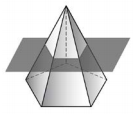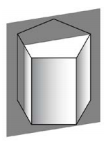General Information
Clusters should not be sorted from Major to Supporting and then taught in that order. To do so would strip the coherence of the mathematical ideas and miss the opportunity to enhance the major work of the grade with the supporting clusters.
Test Item Specifications
Spheres, cones, and cylinders are allowed. Slicing is limited to horizontal or vertical slices. Bases of prisms and pyramids can be a triangle (any type); a square; a rectangle; or a regular pentagon or hexagon. Items should not use composite figures
Neutral
Allowable
Sample Test Items (3)
| Test Item # | Question | Difficulty | Type |
| Sample Item 1 | A pyramid is sliced horizontally as shown.
Use the Connect Line tool to draw a shape that represents the two-dimensional cross section of the pyramid. |
N/A | GRID: Graphic Response Item Display |
| Sample Item 2 | A prism is sliced vertically as shown.
Use the Connect Line tool to draw a shape that represents the cross section of the prism. |
N/A | GRID: Graphic Response Item Display |
| Sample Item 3 | David and Tonya each cut a cylinder in half. The cross-section that results from David's cut is a rectangle. The cross-section that results from Tonya's cut is a circle. How was Tonya's cut different from David's cut? Type your answer in the space provided. |
N/A | OR: Open Response |
Related Courses
| Course Number1111 | Course Title222 |
| 1205040: | M/J Grade 7 Mathematics (Specifically in versions: 2014 - 2015, 2015 - 2022, 2022 - 2024, 2024 and beyond (current)) |
| 1205050: | M/J Accelerated Mathematics Grade 7 (Specifically in versions: 2014 - 2015, 2015 - 2020, 2020 - 2022, 2022 - 2024, 2024 and beyond (current)) |
| 1204000: | M/J Foundational Skills in Mathematics 6-8 (Specifically in versions: 2014 - 2015, 2015 - 2022, 2022 - 2024, 2024 and beyond (current)) |
| 0101010: | M/J Two-Dimensional Studio Art 1 (Specifically in versions: 2014 - 2015, 2015 - 2022, 2022 - 2024, 2024 and beyond (current)) |
| 0101020: | M/J Two-Dimensional Studio Art 2 (Specifically in versions: 2014 - 2015, 2015 - 2022, 2022 - 2024, 2024 and beyond (current)) |
| 0101040: | M/J Three-Dimensional Studio Art 1 (Specifically in versions: 2014 - 2015, 2015 - 2022, 2022 - 2024, 2024 and beyond (current)) |
| 0101050: | M/J Three-Dimensional Studio Art 2 (Specifically in versions: 2014 - 2015, 2015 - 2022, 2022 - 2024, 2024 and beyond (current)) |
| 7812020: | Access M/J Grade 7 Mathematics (Specifically in versions: 2014 - 2015, 2015 - 2018, 2018 - 2019, 2019 - 2022, 2022 and beyond (current)) |
| 0101025: | M/J Two-Dimensional Studio Art 2 & Career Planning (Specifically in versions: 2014 - 2015, 2015 - 2019, 2019 - 2022, 2022 - 2024, 2024 and beyond (current)) |
| 0101005: | M/J Exploring Two-Dimensional Art (Specifically in versions: 2014 - 2015, 2015 - 2022, 2022 - 2024, 2024 and beyond (current)) |
| 0101026: | M/J Two-Dimensional Studio Art 3 (Specifically in versions: 2014 - 2015, 2015 - 2022, 2022 - 2024, 2024 and beyond (current)) |
| 0101035: | M/J Exploring Three-Dimensional Art (Specifically in versions: 2014 - 2015, 2015 - 2022, 2022 - 2024, 2024 and beyond (current)) |
| 0101100: | M/J Visual Art 1 (Specifically in versions: 2015 - 2022, 2022 - 2024, 2024 and beyond (current)) |
| 0101110: | M/J Visual Art 2 (Specifically in versions: 2015 - 2022, 2022 - 2024, 2024 and beyond (current)) |
| 0101120: | M/J Visual Art 3 (Specifically in versions: 2015 - 2022, 2022 - 2024, 2024 and beyond (current)) |
Related Resources
Formative Assessments
| Name | Description |
| Square Pyramid Slices | Students are asked to sketch and describe the two-dimensional figures that result from slicing a square pyramid. |
| Rectangular Prism Slices | Students are asked to sketch and describe two-dimensional figures that result from slicing a rectangular prism. |
| Cylinder Slices | Students are asked to sketch and describe the two-dimensional figures that result from slicing a cylinder. |
| Cone Slices | Students are asked to sketch and describe the two-dimensional figures that result from slicing a cone. |
Lesson Plans
| Name | Description |
| Plane Slice | Describe the two-dimensional figures that result from slicing three-dimensional figures, as in plane sections of right rectangular prisms and right rectangular pyramids. Students will use modeling clay to explore the cross sections that result from slicing a 3-dimensional figure. |
| Can You Cut It? Slicing Three-Dimensional Figures | In this lesson, students will sketch, model, and describe cross-sections formed by a plane passing through a three-dimensional figure. Students will create a cube, right rectangular prism, and right rectangular pyramid using modeling clay dough, and then slice the model using parallel, perpendicular, and intersecting lines. Students will describe the two-dimensional figure resulting from slicing the three-dimensional model. |
Virtual Manipulative
| Name | Description |
| Cross Section Flyer - Shodor | With this online Java applet, students use slider bars to move a cross section of a cone, cylinder, prism, or pyramid. This activity allows students to explore conic sections and the 3-dimensional shapes from which they are derived. This activity includes supplemental materials, including background information about the topics covered, a description of how to use the application, and exploration questions for use with the java applet. |
Student Resources
Virtual Manipulative
| Name | Description |
| Cross Section Flyer - Shodor: | With this online Java applet, students use slider bars to move a cross section of a cone, cylinder, prism, or pyramid. This activity allows students to explore conic sections and the 3-dimensional shapes from which they are derived. This activity includes supplemental materials, including background information about the topics covered, a description of how to use the application, and exploration questions for use with the java applet. |


